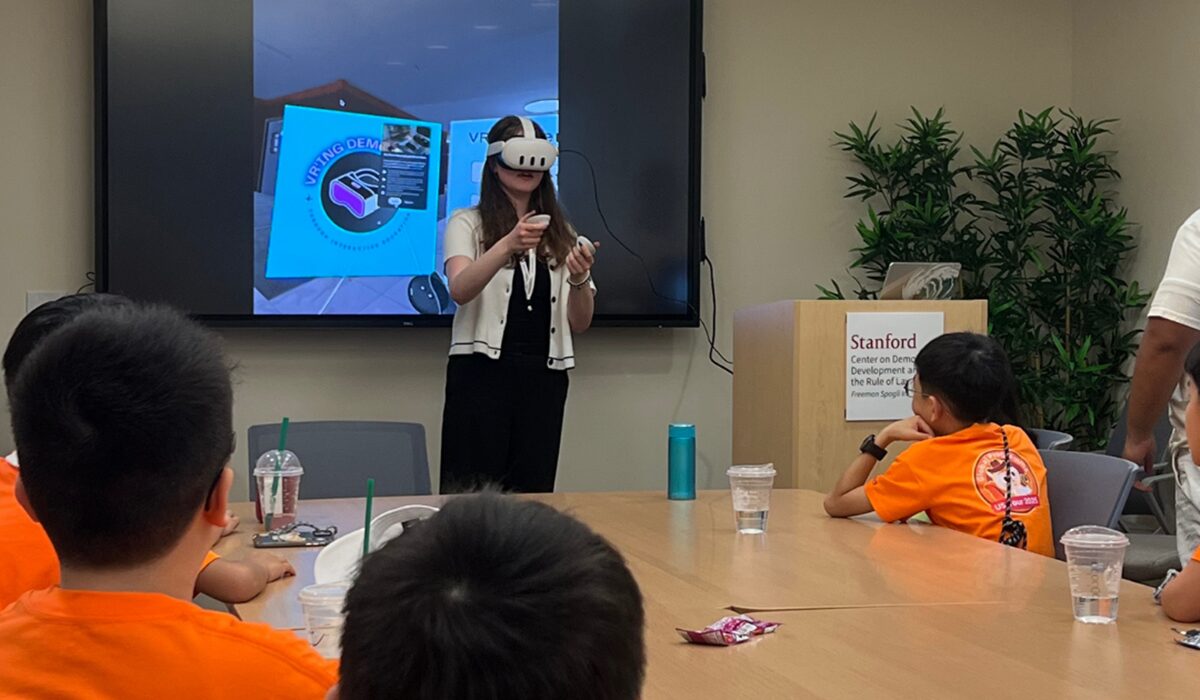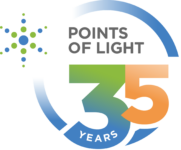Driving Voters to the Polls with Virtual Reality

Meet Daily Point of Light Award honoree Emily Gorodetskiy. Read her story, and nominate an outstanding volunteer or family as a Daily Point of Light.
Seventeen-year-old Emily Gorodetskiy grew up in a house deeply familiar with community service. Having immigrated to the U.S., her mom enjoyed volunteering, in part, as a way to meet people, and it became a family tradition. Emily has been a weekly library volunteer for five years. As a lifelong dancer, she gives lessons to a cohort of kindergarteners and preschoolers—now in grade school–and takes pride in their growth. She, herself, often performs for community events at places like farmers’ markets and senior care centers, finding joy in contributing to a positive environment.
She also co-founded VRing Democracy, an initiative that uses San Francisco’s first multilingual VR polling place simulation to educate voters—particularly immigrants and other first-time voters–and promote civic engagement. Today, the organization has several hubs deploying their own VR headsets at events in partnership with local civic organizations at town halls, community centers and civic forums. The work Emily has done with VRing Democracy has sparked her interest in political systems and her lifelong dedication to the initiative.
What inspires you to volunteer?
I grew up in a household where it was the norm to get involved. My mom was always a big inspiration. She was always really involved in the community. My family immigrated here from Ukraine, and my mom sometimes felt like an outsider, so she found a way to make friends through community service. I started volunteering in elementary school, designing and hanging posters for a food drive.

Tell us about your volunteer role with VRing Democracy.
As the executive director, I work with other youth hub leaders to get them their own headsets so they can run demonstrations in their areas in Massachusetts, Texas, New Jersey and New York. In the beginning, I worked a lot with the League of Women Voters to expand our reach. Now, I have similar partnerships throughout the nation for other hub leaders to connect with, so they can have the same support.
We currently have nine hub leaders, three social media people and a new development team who updates the website and adjusts the experiences for each location. Voting looks different, and the laws are different in each state and even county.
I’ve been representing us at events and leading headset demonstrations. I also write blog posts.
How did you get the initial investment to buy these headsets and develop the simulation?
I entered into a contest called Innovation and Democracy through a civic innovation fellowship I was a part of. We won around $2,250 to buy Meta Quest 3 headsets.
I worked with a few other students on the coding, so they could help with anything I didn’t understand. We also got connected with a professional to ensure that what we were doing was correct, and if we had a bug none of us could solve, we could ask.
Can you walk us through that simulation?
When you open the application, there’s a menu bar that asks if you want to switch languages. We originally had English, Mandarin and Spanish but have since expanded. Then, you pick an interaction, based on your state, that guides you through what the requirements are to vote. After the document page, there are other experiences, like what happens if you cast a vote for a person that you didn’t mean to, or what to do if you’re voting on a machine and it breaks down. The second part guides you through Ballotpedia where you can research candidates and bills.
We’re working on a new experience on what it’s like to canvas for a candidate. We want it to be beginner-friendly, so anybody can understand. Recently, we had a demo for 9- and 10-year-old students, and they had a lot of fun.
What inspired you to get started with this initiative?
In April 2024, my peers seemed to be following the presidential election closely, but when I asked those who were 18 if they planned to vote, they were unsure. They knew it was important but felt like their vote wouldn’t make an impact. As a result, they didn’t want to go out of their way to do so. It was a problem.
When immigrants become able to vote, it can also feel foreign. For the first few years here, my parents didn’t feel compelled to vote; it felt pointless, that their perspectives weren’t going to be heard. Many people are disengaged, sometimes because of language barriers, but often because they just don’t understand the process.
Eighteen- to 24-year-olds represent the lowest percentage of people who cast ballots. Gen Z grew up with phones and tech, so I thought that the best way to raise civic engagement was by connecting storytelling and technology with a VR experience. I had some coding experience, so I had the skills that I needed. And the rest is history.
What are your other long-term plans and goals for the organization?
We’re hoping to build new experiences. The ACLU reached out to do a Know Your Rights VR experience, and that’s the kind of impact and collaboration that we hope to foster.
What’s been the most rewarding part of your work?
Our media reach has been amazing. A local newspaper I grew up reading did a story on us, and when it came out, the bookstore and cafe across from my house had stacks of them with my face on the front page. I never thought we’d be able to have this kind of impact, but it gives people hope for democracy, which is something we really need.
What do you want people to learn from your story?
Never give up. I’ve tried to highlight the positive things that have grown out of this experience, but there were definitely hard days. There were days when I thought this wasn’t going to work. It’s okay to take a day off, go to sleep and come back to it. It took many hours and long Zoom calls to create our simulation, but it was worth it in the end.
Do you want to make a difference in your community like Emily? Find local volunteer opportunities.
